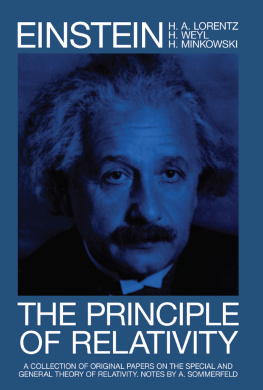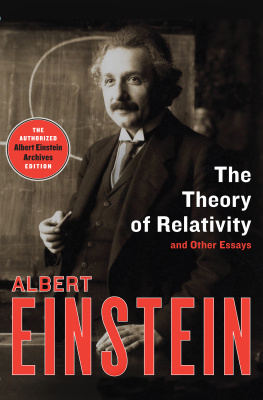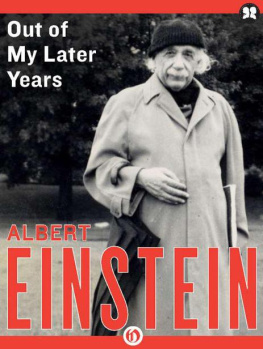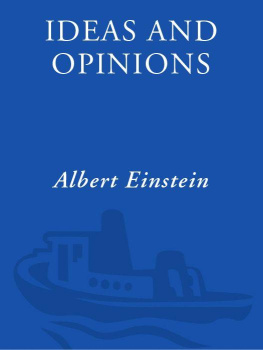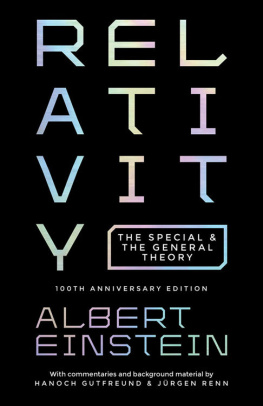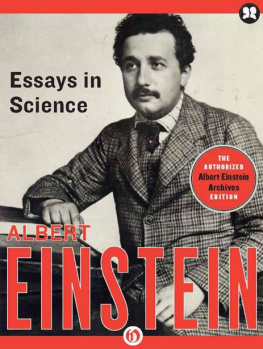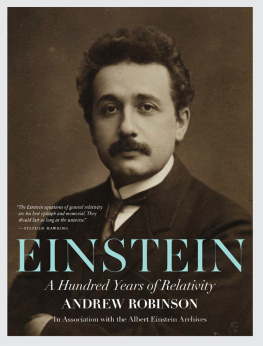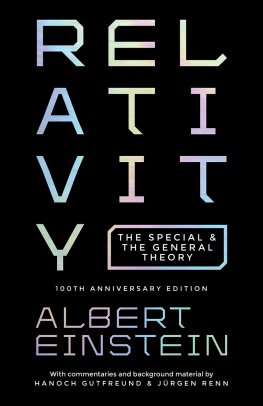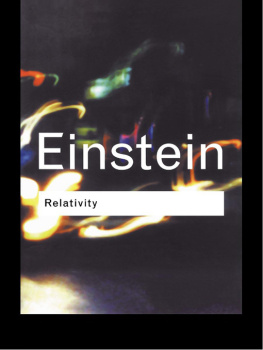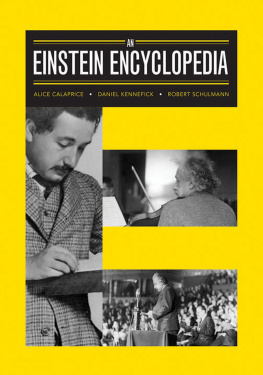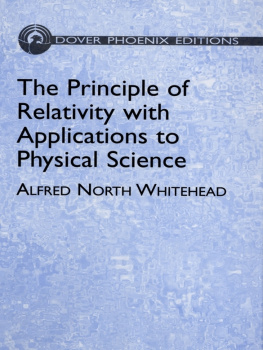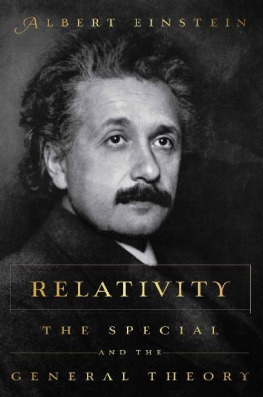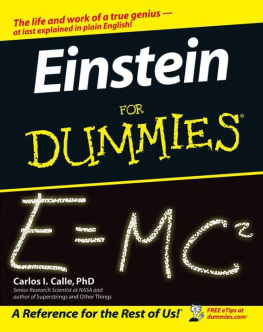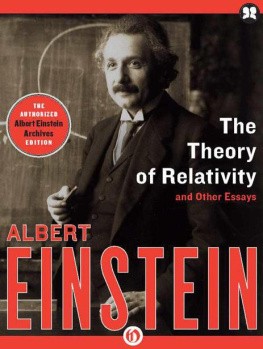Albert Einstein - The Principle of Relativity
Here you can read online Albert Einstein - The Principle of Relativity full text of the book (entire story) in english for free. Download pdf and epub, get meaning, cover and reviews about this ebook. year: 2013, publisher: Dover Publications, genre: Romance novel. Description of the work, (preface) as well as reviews are available. Best literature library LitArk.com created for fans of good reading and offers a wide selection of genres:
Romance novel
Science fiction
Adventure
Detective
Science
History
Home and family
Prose
Art
Politics
Computer
Non-fiction
Religion
Business
Children
Humor
Choose a favorite category and find really read worthwhile books. Enjoy immersion in the world of imagination, feel the emotions of the characters or learn something new for yourself, make an fascinating discovery.
- Book:The Principle of Relativity
- Author:
- Publisher:Dover Publications
- Genre:
- Year:2013
- Rating:3 / 5
- Favourites:Add to favourites
- Your mark:
- 60
- 1
- 2
- 3
- 4
- 5
The Principle of Relativity: summary, description and annotation
We offer to read an annotation, description, summary or preface (depends on what the author of the book "The Principle of Relativity" wrote himself). If you haven't found the necessary information about the book — write in the comments, we will try to find it.
The Principle of Relativity — read online for free the complete book (whole text) full work
Below is the text of the book, divided by pages. System saving the place of the last page read, allows you to conveniently read the book "The Principle of Relativity" online for free, without having to search again every time where you left off. Put a bookmark, and you can go to the page where you finished reading at any time.
Font size:
Interval:
Bookmark:
THE PRINCIPLE OF RELATIVITY
A COLLECTION OF ORIGINAL MEMOIRS ON THE SPECIAL AND GENERAL THEORY OF RELATIVITY
BY
H. A. LORENTZ, A. EINSTEIN H. MINKOWSKI AND H. WEYL
WITH NOTES BY
A. SOMMERFELD
TRANSLATED BY
W. PERRETT AND G. B. JEFFERY
WITH SEVEN DIAGRAMS
DOVER PUBLICATIONS, INC.
This Dover edition, first published in 1952, is an unabridged and unaltered republication of the 1923 translation first published by Methuen and Company, Ltd. in 1923. This edition is reprinted through special arrangement with Methuen and Company and Albert Einstein.
Standard Book Number: 486-60081-5
Library of Congress Catalog Card Number: A52-9845
Manufactured in the United States by Courier Corporation
60081538
www.doverpublications.com
TRANSLATORS PREFACE
T HE Theory of Relativity is at the moment the subject of two main lines of inquiry : there is an endeavour to express its principles in logical and concise form, and there is the struggle with analytical difficulties which stand in the way of further progress. In the midst of such problems it is easy to forget the way in which the theory gradually grew under the stimulus of physical experiment, and thus to miss much of its meaning. It is this growth which the present collection of papers is designed chiefly to exhibit. In the earlier papers there are some things which the authors would no doubt now express differently ; the later papers deal with problems which are not by any means yet fully solved. At the end we must confess that Relativity is still very much of a problemand therefore worthy of our study.
The authors of the papers are still actively at work on the subjectall save Minkowski. His paper on Space and Time is a measure of the loss which mathematical physics suffered by his untimely death.
The translations have been made from the text, as published in a German collection, under the title Des Relativitatsprinzip (Teubner, 4th ed., 1922). The second paper by Lorentz is an exception to this. It is reprinted from the original English version in the Proceedings of the Amsterdam Academy. Some minor changes have been made, and the notation has been brought more nearly into conformity with that employed in the other papers.
W. P.
G. B. J.
TABLE OF CONTENTS
MICHELSONS INTERFERENCE EXPERIMENT
By
H. A. LORENTZ
Translated from Versuch einer Theorie der elektrischen und optischen Erscheinungen in bewegten Krpern, Leiden, 1895, 89-92.
MICHELSONS INTERFERENCE EXPERIMENT
By H. A. LORENTZ
1.A S Maxwell first remarked and as follows from a very simple calculation, the time required by a ray of light to travel from a point A to a point B and back to A must vary when the two points together undergo a displacement without carrying the ether with them. The difference is, certainly, a magnitude of second order ; but it is sufficiently great to be detected by a sensitive interference method.
The experiment was carried out by Michelson in 1881. His apparatus, a kind of interferometer, had two horizontal arms, P and Q, of equal length and at right angles one to the other. Of the two mutually interfering rays of light the one passed along the arm P and back, the other along the arm Q and back. The whole instrument, including the source of light and the arrangement for taking observations, could be revolved about a vertical axis; and those two positions come especially under consideration in which the arm P or the arm Q lay as nearly as possible in the direction of the Earths motion. On the basis of Fresnels theory it was anticipated that when the apparatus was revolved from one of these principal positions into the other there would be a displacement of the interference fringes.
But of such a displacementfor the sake of brevity we will call it the Maxwell displacementconditioned by the change in the times of propagation, no trace was discovered, and accordingly Michelson thought himself justified in concluding that while the Earth is moving, the ether does not remain at rest. The correctness of this inference was soon brought into question, for by an oversight Michelson had taken the change in the phase difference, which was to be expected in accordance with the theory, at twice its proper value. If we make the necessary correction, we arrive at displacements no greater than might be masked by errors of observation.
Subsequently Michelson took up the investigation anew in collaboration with Morley, enhancing the delicacy of the experiment by causing each pencil to be reflected to and fro between a number of mirrors, thereby obtaining the same advantage as if the arms of the earlier apparatus had been considerably lengthened. The mirrors were mounted on a massive stone disc, floating on mercury, and therefore easily revolved. Each pencil now had to travel a total distance of 22 meters, and on Fresnels theory the displacement to be expected in passing from the one principal position to the other would be 04 of the distance between the interference fringes. Nevertheless the rotation produced displacements not exceeding 0 02 of this distance, and these might well be ascribed to errors of observation.
Now, does this result entitle us to assume that the ether takes part in the motion of the Earth, and therefore that the theory of aberration given by Stokes is the correct one? The difficulties which this theory encounters in explaining aberration seem too great for me to share this opinion, and I would rather try to remove the contradiction between Fresnels theory and Michelsons result. An hypothesis which I brought forward some time ago, enables us to do this. The next paragraph will set out this hypothesis.
the turning of the apparatus through 90 causes the time in which the one pencil travels along P and back to be longer than the time which the other pencil takes to complete its journey by

There would be this same difference if the translation had no influence and the arm P were longer than the arm Q by  Lv2/c2. Similarly with the second principal position.
Lv2/c2. Similarly with the second principal position.
Thus we see that the phase differences expected by the theory might also arise if, when the apparatus is revolved, first the one arm and then the other arm were the longer. It follows that the phase differences can be compensated by contrary changes of the dimensions.
If we assume the arm which lies in the direction of the Earths motion to be shorter than the other by  Lv2/c2, and, at the same time, that the translation has the influence which Fresnels theory allows it, then the result of the Michelson experiment is explained completely.
Lv2/c2, and, at the same time, that the translation has the influence which Fresnels theory allows it, then the result of the Michelson experiment is explained completely.
Thus one would have to imagine that the motion of a solid body (such as a brass rod or the stone disc employed in the later experiments) through the resting ether exerts upon the dimensions of that body an influence which varies according to the orientation of the body with respect to the direction of motion. If, for example, the dimensions parallel to this direction were changed in the proportion of 1 to 1 + , and those perpendicular in the proportion of 1 to 1 + , then we should have the equation

in which the value of one of the quantities and would remain undetermined. It might be that 
Font size:
Interval:
Bookmark:
Similar books «The Principle of Relativity»
Look at similar books to The Principle of Relativity. We have selected literature similar in name and meaning in the hope of providing readers with more options to find new, interesting, not yet read works.
Discussion, reviews of the book The Principle of Relativity and just readers' own opinions. Leave your comments, write what you think about the work, its meaning or the main characters. Specify what exactly you liked and what you didn't like, and why you think so.

